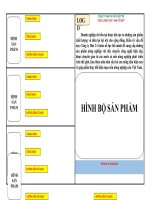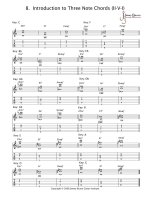EPA an introduction to fresh water musselsas bioindicators EPA 260 r 08 015 tủ tài liệu bách khoa
Bạn đang xem bản rút gọn của tài liệu. Xem và tải ngay bản đầy đủ của tài liệu tại đây (3.35 MB, 122 trang )
An Introduction to
Freshwater Mussels as
Biological Indicators
Including Accounts of Interior Basin,
Cumberlandian, and Atlantic Slope
Species
EPA-260-R-08-015
November 2008
An Introduction to
Freshwater Mussels as
Biological Indicators
Including Accounts of Interior Basin,
Cumberlandian, and Atlantic Slope Species
Prepared by:
Jeffrey D. Grabarkiewicz1 and Wayne S. Davis2
1
Ecological Survey and Design, LLC
1517 W. Temperance Rd.
Temperance, MI 48182
U.S. Environmental Protection Agency
Office of Environmental Information
Office of Information Analysis and Access
Washington, DC 20460
2
U.S. Environmental Protection Agency
Office of Environmental Information
Office of Information Analysis and Access
Washington, DC 20460
Printed on chlorine free 100% recycled paper with
100% post-consumer fiber using vegetable-based ink.
An Introduction to Freshwater Mussels as Biological Indicators
Notice
This document has been reviewed and approved in accordance
with U.S. Environmental Protection Agency policy. Mention
of trade names, products, or services does not convey and
should not be interpreted as conveying official EPA approval,
endorsement, or recommendation for use.
Funding was provided by the U.S. Environmental Protection
Agency under Contract # 68-C-04-006, Work Assignment #4-79
with the Great Lakes Environmental Center, Inc.
The appropriate citation for this report is:
Grabarkiewicz, J. and W. Davis. 2008. An introduction to
freshwater mussels as biological indicators. EPA-260-R
08-015. U.S. Environmental Protection Agency, Office of
Environmental Information, Washington, DC.
The entire document can be downloaded from:
/>
AckNowledgemeNts
We would like to thank the many individuals who provided
manuscripts and papers for our review and reference. Thanks
also to the University of Michigan Museum of Zoology and the
Ohio State Museum of Biological Diversity for providing access
to their collections. Last, but certainly not least, thank you to
the reviewers who took the time to look over this document,
including Dr. Tom Augspurger, Dr. Chris Barnhart, Dr. Arthur
Bogan, Dr. Hans Gottgens, Edward Hammer, Tina Hendon, Dr.
Teresa Newton, Dr. Brenda Rashleigh, Brett Rodstrom, and John
Tetzloff.
v
An Introduction to Freshwater Mussels as Biological Indicators
coNteNts
Notice..........................................................................................................v
Acknowledgements...................................................................................v
Part One - Introduction and Indicator Use
Introduction.................................................................................................................................. 1
Distribution and Conservation Status .......................................................................................... 2
Freshwater Mussel Ecology......................................................................................................... 4
Freshwater Mussel Reproduction ................................................................................................ 6
Shell Morphology......................................................................................................................... 8
Sampling Freshwater Mussels.....................................................................................................10
Freshwater Mussels as Biological Indicators...............................................................................15
Tolerance to Habitat Alteration..............................................................................................17
Indicators of Biological Integrity............................................................................................18
Sensitivity to Toxic Contaminants .........................................................................................20
Heavy metals ..................................................................................................................21
Ammonia .........................................................................................................................25
Chlorine ...........................................................................................................................27
Insecticides, Herbicides, and Fungicides ........................................................................27
Shells as Indicators ..............................................................................................................29
Part Two - Genus and Species Accounts
Genus Accounts
Alasmidonta Say, 1818 ........................................................................................................31
Epioblasma Rafinesque, 1831............................................................................................34
Fusconaia Simpson, 1900 .................................................................................................37
Lampsilis Rafinesque, 1820 ...............................................................................................40
Lasmigona Rafinesque, 1831.............................................................................................44
Pleurobema Rafinesque, 1819 ............................................................................................47
Quadrula Rafinesque, 1820................................................................................................50
Species Accounts
Mucket (Actinonaias ligamentina).........................................................................................53
Pheasantshell (Actinonaias pectorosa) ................................................................................54
Dwarf Wedgemussel (Alasmidonta heterodon) ....................................................................55
Elktoe (Alasmidonta marginata) ...........................................................................................56
Threeridge (Amblema plicata) ..............................................................................................57
vi
An Introduction to Freshwater Mussels as Biological Indicators
coNteNts (coN’t)
Species Accounts*
Purple Wartyback (Cyclonaias tuberculata) .........................................................................58
Dromedary Pearlymussel (Dromus dromas) ........................................................................59
Eastern Elliptio (Elliptio complanata)....................................................................................60
Spike (Elliptio dilatata) ..........................................................................................................61
Oyster Mussel (Epioblasma capsaeformis) ..........................................................................62
Northern Riffleshell (Epioblasma torulosa rangiana)............................................................63
Tubercled Blossom (Epioblasma torulosa torulosa)..............................................................64
Wabash Pigtoe (Fusconaia flava) .........................................................................................65
Pink Mucket (Lampsilis abrupta) ..........................................................................................66
Plain Pocketbook (Lampsilis cardium)..................................................................................67
Wavyrayed Lampmussel (Lampsilis fasciola) .......................................................................68
Fat Mucket (Lampsilis siliquoidea)........................................................................................69
White Heelsplitter (Lasmigona complanata complanata) .....................................................70
Flutedshell (Lasmigona costata)...........................................................................................71
Black Sandshell (Ligumia recta) ...........................................................................................72
Cumberland Moccasinshell (Medionidus conradicus) ..........................................................73
Threehorn Wartyback (Obliquaria reflexa)............................................................................74
Sheepnose (Plethobasus cyphyus) ......................................................................................75
Clubshell (Pleurobema clava)...............................................................................................76
Ohio Pigtoe (Pleurobema cordatum) ....................................................................................77
Round Pigtoe (Pleurobema sintoxia)....................................................................................78
Kidneyshell (Ptychobranchus fasciolaris) .............................................................................79
Fluted Kidneyshell (Ptychobranchus subtentum) .................................................................80
Giant Floater (Pyganodon grandis) ......................................................................................81
Rabbitsfoot (Quadrula cylindrica cylindrica) .........................................................................82
Pimpleback (Quadrula pustulosa pustulosa) ........................................................................83
Mapleleaf (Quadrula quadrula).............................................................................................84
Creeper (Strophitus undulatus) ............................................................................................85
Pistolgrip (Tritogonia verrucosa) ...........................................................................................86
Rainbow (Villosa iris) ............................................................................................................87
Conservation Status Table........................................................................................... 88
Glossary ........................................................................................................................ 89
Literature Cited ............................................................................................................. 90
*Taxonomic Note: To simplify the taxonomy of this guide, all
names follow Turgeon et al. (1998). However, we recognize that
this may not represent the most current taxonomic scheme.
vii
An Introduction to Freshwater Mussels as Biological Indicators
Figures
Figure 1. (Top) Total number of freshwater mussel species by state.
(Bottom) Percentage of imperiled freshwater mussel species by state. ........................................ 2
Figure 2. Freshwater mussel faunal provinces.............................................................................. 3
Figure 3. Proportion of species at risk by plant and animal group................................................ 3
Figure 4. Various beak sculptures................................................................................................. 8
Figure 5. Basic shell anatomy. ...................................................................................................... 8
Figure 6. Basic shell orientation.................................................................................................... 9
Figure 7. Inner soft tissue ............................................................................................................. 9
Figure 8. Hypothetical qualitative bridge survey............................................................................12
Figure 9. A systematic sampling design along 2 transects with 3 random starts..........................13
Figure 10. Hypothetical survey layout using the ORVET protocol ................................................15
Figure 11. A listing of the most sensitive aquatic genera to copper
excluding freshwater mussels........................................................................................................23
Figure 12. A listing of the most sensitive aquatic genera to copper
including freshwater mussel taxa ..................................................................................................23
Figure 13. A listing of the most sensitive aquatic genera to ammonia
excluding freshwater mussel taxa..................................................................................................25
Figure 14. A listing of the most sensitive aquatic genera to ammonia
including freshwater mussel taxa ..................................................................................................26
Figure 15. External rings of the Ohio Pigtoe (Pleurobema cordatum)..........................................29
viii
An Introduction to Freshwater Mussels as Biological Indicators
PhotogrAPhs
Photo 1. A Kidneyshell (Ptychobranchus fasciolaris) repositioning in the substrate ................... 4
Photo 2. Small fishes, such as this Brindled Madtom (Noturus miurus), often take
shelter in the spent shells of freshwater mussels (Photo: Threeridge shell) ................................ 5
Photo 3. The Spike (Elliptio dilatata) blanketed in periphyton ..................................................... 5
Photo 4. Water pennies (Psephenidae sp.) grazing on a White Heelsplitter
shell (Lasmigona complanata complanata) . ................................................................................ 5
Photo 5. The mantle flap lure of the Plain Pocketbook (Lampsilis cardium) ............................... 6
Photo 6. The charged gills of the Plain Pocketbook (Lampsilis cardium) ................................... 6
Photo 7. A 12 mm Rayed Bean (Villosa fabalis) attached to a small piece
of gravel via byssal threads .......................................................................................................... 7
Photo 8. Clinch River, TN ............................................................................................................ 10
Photo 9. Sampling a small creek with a view-bucket and snorkeling gear .................................. 10
Photo 10. Typical diving gear used by biologists searching for mussels...................................... 11
Photo 11. Mussel researcher utilizing an underwater viewer....................................................... 11
Photo 12. Researcher sorting mussels for identification and measurement................................ 11
Photo 13. Unionids collected during a qualitative survey............................................................. 12
Photo 14. Excavating sediments within a 0.25 m2 quadrat during a
quantitative survey. ...................................................................................................................... 14
Photo 15. Excavating sediments within a 0.25 m2 quadrat during a
quantitative survey ....................................................................................................................... 14
Photo 16. The Green River, KY, home to 71 mussel species and 151
fish species .................................................................................................................................. 16
Photo 17. The Shelbyville dam, Duck River, TN........................................................................... 17
Photo 18. A researcher measures a mussel with a caliper to collect
demographic data......................................................................................................................... 19
Photo 19. Swan Creek, OH, headwater habitat of the Slippershell
Mussel (Alasmidonta viridis)......................................................................................................... 31
Photo 20. Slippershell Mussel (Alasmidonta viridis), Swan Creek, OH. ...................................... 31
Photo 21. The Oyster Mussel (Epioblasma capsaeformis), Clinch River, TN .............................. 34
Photo 22. The Powell River (TN, VA) was historically home to several
species of Epioblasma, including the extinct Forkshell (Epioblasma lewisii)
and Acornshell (Epioblasma haysiana) ........................................................................................ 34
Photo 23. Roanoke River, VA, home to the Atlantic Pigtoe (Fusconaia masoni). ........................ 37
Photo 24. The Wabash Pigtoe (Fusconaia flava), Swan Creek, OH............................................ 38
ix
An Introduction to Freshwater Mussels as Biological Indicators
PhotogrAPhs (coN’t)
Photo 25. Streamline chubs (Erimystax dissimilis) foraging above a
Longsolid (Fusconaia subrotunda), French Creek, PA. ................................................................ 38
Photo 26. Cumberland River, KY, home to the Ebonyshell (Fusconaia ebena),
Longsolid (Fusconaia subrotunda), and Wabash Pigtoe (Fusconaia flava).................................. 39
Photo 27. Lake Michigan, home to the Plain Pocketbook (Lampsilis cardium)
and Fatmucket (Lampsilis siliquoidea).......................................................................................... 41
Photo 28. In-situ mantle flap lure of the Wavyrayed Lampmussel. .............................................. 43
Photo 29. In-situ apertures of the Plain Pocketbook.................................................................... 43
Photo 30. The Flutedshell (Lasmigona costata) in French Creek, PA.......................................... 45
Photo 31. Green River, KY, home to the Flutedshell (Lasmigona costata) and
White Heelsplitter (Lasmigona complanata complanata). ............................................................ 46
Photo 32. The Green River (KY), home of the federally endangered
Rough Pigtoe (Pleurobema plenum). ........................................................................................... 48
Photo 33. The federally endangered Clubshell (Pleurobema clava),
French Creek, PA.......................................................................................................................... 48
Photo 34. East Fork West Branch St. Joseph River, MI, habitat of the
Clubshell (Pleurobema clava)....................................................................................................... 49
Photo 35. Rabbitsfoot (Quadrula cylindrica cylindrica), French Creek, PA. ................................. 51
Photo 36. French Creek, PA, habitat of the Rabbitsfoot (Quadrula cylindrica cylindrica). ........... 52
All photographs by Jeff Grabarkiewicz and Todd Crail
x
An Introduction to Freshwater Mussels as Biological Indicators
iNtroductioN
While marine environments harbor the delicate beauty of the seahorse, coral reef, and
anemone, North American freshwater streams and lakes support a splendor all their own.
Freshwater mussels, also called pearly mussels, naiads, or clams, are a diverse group of
creatures that are both unassuming and inconspicuous. Most will not confound passersby
with oddities or evoke awe-inspired gasps from onlookers. In fact, many spend a good
deal of their life partially or wholly buried in stream sediments, detectable to only the most
astute observer. Yet, despite their mild manner and cryptic nature, evolution has bestowed
a great variety of these creatures on the North American continent. And we should
consider ourselves fortunate! Not only do these mussels possess a unique elegance and
beauty, but they also exhibit a dizzying array of adaptations and life history strategies.
As a group, freshwater mussels are differentiated from other bivalves by their unique life
cycle. This life cycle includes a parasitic larval stage that requires, in most cases, a fish
host to complete. Adult mussels can measure up to ten inches in length and, under certain
conditions, live more than 100 years (Bauer 1987; Cummings and Mayer 1992).
From an economic perspective, mussels have been valued for their beauty, shell material,
and natural pearls for centuries. Unfortunately, this has also led to the overharvesting
of mussel resources. For example, during the mid-1800s, freshwater mussels were
commonly collected by people seeking fortune in the form of freshwater pearls. Following
a valuable discovery, successive collecting often led to the wholesale destruction of entire
mussel beds (Anthony and Downing 2001). The pearl button industry, founded during the
late 1800s, provides another example of overharvesting leading to resource depletion. This
industry created buttons from the durable shells of freshwater mussels. Thousands of tons
of shells were harvested in Eastern North America from the late 1800s to the mid 1900s to
fuel the button industry. Coker et al. (1921) eloquently observed “equal as they were to the
vicissitudes of natural conditions, they were unable to withstand the unchecked ravages
of commercial fishery”. Freshwater mussels continue to be an important economic and
ecological resource (Anthony and Downing 2001, Pritchard 2001).
The primary purpose of this guide is to encourage the use of freshwater mussels for water
quality assessment and to briefly review their use as biological indicators and biomonitors.
This document is not intended as a “how to” manual or methods document, but as an
educational tool. It was designed and written with a wide audience in mind, including
academic institutions, natural resource managers, park naturalists, conservationists,
monitoring groups, environmental managers, and interested citizens. Several topics will
be examined in detail, including ecology, reproduction, indicator use, sensitivity to toxic
contaminants, survey methodologies. In addition, species records are included with
pictures to assist in identification and indicator usage.
1
An Introduction to Freshwater Mussels as Biological Indicators
distributioN ANd coNservAtioN stAtus
Freshwater mussels (Bivalvia: Unionoida) are distributed nearly worldwide, inhabiting
every continent on Earth except Antarctica. Approximately 780 species belonging to 140
genera have been identified, with species diversity maximized in the creeks, rivers, and
lakes of North America (Graf and Cummings 2007). Globally, six families of freshwater
mussels are known, although
only two occur in North
Total Number
America - the Unionidae and
10
5
Margaritiferidae. The Unionidae
16 12
4
14
5
makeup the vast majority of the
44
12
4
50
30
24
North American fauna. Overall,
4
10
45
63
48
approximately 300 species
12
11
3
78
4
77
79
12
of mussels are found in the
6
50 80
4
44
12
65
103
U.S., with the highest species
19
50
131
richness found in the Southeast
55
1
70
33
3
(Fig. 1) (Neves et al. 1997).
84 175 99
64
53
Various unionoid faunal
zones have been identified by
malacologists during the past
century (e.g. Simpson 1900;
van der Schalie and van der
Schalie 1950; Parmalee and
Bogan 1998; Abell et al. 2000).
This guide borrows from the
interpretation introduced by
Parmalee and Bogan (1998)
(Fig. 2). Faunal regions are
useful when attempting to
describe the distribution
patterns and evolutionary
characteristics of freshwater
mussels. For example, some
faunal provinces represent
areas of considerable
endemism, such as the
Ozarkian, Cumberlandian, and
Mobile Basin. Within these
regions, faunal “hotspots” occur
that support unionoid species
found nowhere else on Earth.
51
0
2
Percentage Imperiled
50
38 50
0
0
0
0
0
0
14
25
27
17
0
0
33
30
33
38
47
36
31
0
0
30
49 49 63
43
41
34
58
68
48 70
49
46 71
60
55
58
50
58
58
58
68
67
57
0
0
(Source: LaRoe et al. 1995)
Figure 1: (Top) Total number of freshwater mussel species
by state. (Bottom) Percentage of imperiled freshwater mussel
species by state.
2
An Introduction to Freshwater Mussels as Biological Indicators
(Source: Parmalee and Bogan (1998), The Freshwater Mussels of Tennessee.
University of Tennessee Press. Permission granted by the authors.)
Figure 2: Freshwater mussel faunal provinces.
While historically highly diverse
and abundant throughout a good
portion of the U.S., unionoids are
now one of the most imperiled
groups nationwide (Fig. 3).
Approximately 70% of the North
American fauna is in various
states of decline (Williams et
al. 1993; Master et al. 2000;
NatureServe 2008). Sadly, 37
species are now presumed
extinct (Master et al. 2000). This
decline is often attributed to
habitat destruction, water quality
degradation, damming, exotic
species, and hydrologic changes
(Williams et al. 1993; Strayer et
al. 2004).
(Source: Precious Heritage, ©TNC and NatureServe, 2000)
Figure 3: Proportion of species at risk by plant and animal
group.
3
An Introduction to Freshwater Mussels as Biological Indicators
FreshwAter mussel ecology
Freshwater mussels play a number of important roles in aquatic ecosystems. As sedentary
suspension feeders, unionoids remove a variety of materials from the water column,
including sediment, organic matter, bacteria, and phytoplankton. Siphoned material is
either transferred to the mouth for digestion or sloughs off the gills and exits via the ventral
margin of the shell (pseudofeces). Digested material is either used as fuel for various
life processes or excreted as feces. The amount and rate of particulate matter removed
from the water column and subsequent deposition of waste is largely dependent on
temperature, particle concentration, flow regime, mussel size, and species (Vaughn and
Hakenkamp 2001). While the siphoning activities of mussels are often overlooked, they
provide an integral resource link between pelagic and benthic habitats (Nelepa et al. 1991;
Howard and Cuffey 2006).
Mussels also interact with stream sediments.
The burrowing behavior of unionids mixes
sediment pore water, releasing nutrients and
oxygenating substrates (Photo 1) (Vaughn
and Hakenkamp 2001). Particularly dense
assemblages of mussels may influence
substrate stability and provide nutrients and
microrefugia for benthic life (Vaughn and
Hakenkamp 2001; Zimmerman and de Szalay
2007).
Juvenile mussels have demonstrated the
ability to pedal feed by sweeping their foot
to collect food particles from sediments.
Studies conducted by Gatenby et al. (1996)
documented the importance of sediments
to the growth of juvenile Rainbow (Villosa
iris). Researchers reported increased shell
growth and survival rates when algal diets
were supplemented with a fine sediment
substratum.
Photo 1: A Kidneyshell (Ptychobranchus
fasciolaris) repositioning in the substrate.
4
An Introduction to Freshwater Mussels as Biological Indicators
Freshwater mussels also provide food
for a number of terrestrial and aquatic
species. Raccoons, muskrats, otters,
fishes, turtles, and birds all feed on
mussels. The cracked valves and
weathered remains of unionids often litter
gravel bars and floodplains, a testament
to the efficiency of terrestrial predators.
The spent valves of freshwater mussels
play a role in aquatic ecosystems as well.
Shells provide habitat for a variety of
life, including fish (Photo 2), periphyton
(Photo 3), crustaceans, molluscs,
and macroinvertebrates (Photo 4).
Additionally, the weathering and eventual
erosion of shell material recycles calcium
carbonate back to aquatic ecosystems.
Photo 2: Small fishes, such as this Brindled
Madtom (Noturus miurus), often take shelter
in the spent shells of freshwater mussels
(Photo: Threeridge shell).
Photo 3: The Spike (Elliptio dilatata) blanketed
in periphyton.
Photo 4: Water pennies (Psephenidae sp.)
grazing on a White Heelsplitter shell (Lasmigona
complanata complanata).
5
An Introduction to Freshwater Mussels as Biological Indicators
FreshwAter mussel reProductioN
The reproductive characteristics and
processes found among the Unionoidea
are diverse, complex, and more than a
little intriguing. As a group, they exhibit
extraordinary variations in fecundity, brooding
tendencies, host specificity, and “luring”
techniques (Photo 5) (Watters 1995; Haag
and Warren 1999; Haag and Staton 2003;
Haag and Warren 2003).
While sexes are separate in most freshwater
mussels, hermaphroditic species have
been reported (van der Schalie 1970). The
reproductive process is initiated when an
upstream male releases sperm into the water
column and a downstream female collects it
via the incurrent aperture. Fertilization occurs
internally, with embryo development ensuing
within the marsupia (gill pouches) (Photo 6).
The resulting larvae, termed “glochidia,” are
brooded by the female for a period of time
ranging from a few weeks to several months.
While some species use all four gills to brood
(e.g. Quadrula), others use only the outer gills
or specialized portions of the outer gills (e.g.
Lampsilis). Once released, glochidia are, for
the most part, obligate parasites that must
find a suitable host or perish.
With few exceptions, freshwater mussels
utilize freshwater and anadromous fishes
as hosts. While some mussel species have
proven capable of parasitizing a wide range
of fish hosts, others are seemingly more
specific. For example, laboratory host studies
Photos 5 and 6: (Top) The mantle flap lure of the
Plain Pocketbook (Lampsilis cardium). (Bottom)
The charged gills of the Plain Pocketbook
(Lampsilis cardium).
6
An Introduction to Freshwater Mussels as Biological Indicators
suggest that the Giant Floater (Pyganodon
grandis) may be capable of successfully
transforming on nearly 40 species (Watters
1994; Watters 1995). Conversely, Layzer et al.
(2003) exposed 18 species of fish (from six
families) to the glochidia of the Cumberland
Pigtoe (Pleurobema gibberum) and reported
just two species as suitable hosts. Glochidia
that successfully locate a host species attach to
the fins, skin, or gills. Once attached, glochidia
feed on host tissue and develop anatomical
structures. After a period of time, the glochidia
excyst and drop off into the substrate or attach
to objects with byssal threads (Photo 7).
Photo 7: A 12 mm Rayed Bean (Villosa
fabalis) attached to a small piece of gravel via
byssal threads.
Freshwater mussels utilize a variety of structures and techniques to attract potential
host species. For example, several members of the genus Lampsilis display a mantle
flap lure (Photos 5 and 6) to entice various piscivorous hosts, including species such
the Largemouth Bass, Rock Bass, and Black Crappie. When the mantle lure is struck
by an unsuspecting fish, the female responds by expelling glochidia out of the excurrent
siphon and infecting the potential host. The Fusconaia utilize a markedly different
strategy, packaging glochidia in capsule-like cases termed “conglutinates.” After being
ejected into the water column, the conglutinates are fed on by fishes, initiating glochidial
attachment to the gills of potential host fishes. A few species have the ability to produce
“superconglutinates,” gelatinous masses that are attached to the female mussel via
a mucus cord. The minnow-like masses “swim” back and forth in the current, and are
presumably preyed upon by species such as the Smallmouth Bass (Haag and Warren
1997).
7
An Introduction to Freshwater Mussels as Biological Indicators
shell morPhology
In order to accurately identify freshwater
mussels, some basic knowledge of shell
morphology is required. While some species
have distinctive features that allow for instant
identification, others are much more cryptic. In
addition, young mussels often vary significantly
in shape, thickness, length, color, and inflation
when compared to older individuals. To
further complicate matters, the same species
may vary in appearance from watershed to
watershed, or even within the same watershed.
Perhaps the easiest (and most efficient) way
to become proficient with the identification of
mussels is to visit an established collection.
Many major universities maintain collections
of mollusks that are open to researchers
and interested naturalists by appointment.
Additionally, numerous regional and state
guides are now available at reasonable prices
(e.g. Oesch 1984; Cummings and Mayer 1992;
Parmalee and Bogan 1998; WDNR 2003).
elevated and
heavy ridges
double-looped
ridges
concentric
coarse ridges
numerous wavy
ridges
concentric
fine ridges
Figure 4: Various beak sculptures.
Figure 5: Basic shell anatomy.
8
An Introduction to Freshwater Mussels as Biological Indicators
Figure 6: Basic shell orientation.
Figure 7: Inner soft tissue.
9
An Introduction to Freshwater Mussels as Biological Indicators
Photo 8: Clinch River, TN.
sAmPliNg FreshwAter mussels
General Overview
Freshwater mussel sampling designs and techniques are largely dependent on the
resources available, sampling conditions, survey objectives, and prior knowledge of the
target population(s) (Strayer and Smith 2003). Surveys range from informal or qualitative
timed searches to intensive, quantitative designs aimed at providing precise population
estimates.
Survey area size and water depth play an
important role in determining sampling
techniques. For example, small, shallow
streams can often be effectively sampled with
little more than a view-bucket or mask and
snorkel (Photos 9 and 11). However, large
streams, rivers, and lakes usually require
SCUBA gear (Photo 10) or surface-supplied
air (SSA) systems. Biologists and commercial
divers utilize a widerange of SSA systems,
some of which are intended for recreational
Photo 9: Sampling a small creek with a viewpurposes while others are designed for
bucket and snorkeling gear.
deepwater diving. Hookah compressors
(recreational) are popular when surveying
small streams where the water is clean and
relatively shallow. Conversely, navigational channels often require the use of SCUBA
gear or commercial SSA dive stations. Commercial dive stations usually permit divers to
communicate with a topside dive supervisor as well as each other; thereby adding an extra
degree of comfort and safety to dive operations. Commercial systems may also utilize a
“hardhat,” a helmet that completely encapsulates the head, protecting the ears and oral-
10
An Introduction to Freshwater Mussels as Biological Indicators
nasal passages
from contact
with the water
column. This may
be especially
important when
surveying in
contaminated
environments.
Sampling
conditions and
Photo 11: Mussel researcher utilizing an
underwater viewer.
the habits of
freshwater
mussels can
make them difficult to detect. Detection is usually
related to substrate type, species, mussel length,
instream vegetation, and observer proficiency (Smith et
al. 2001a). Mussel investigators often use their hands
to gently feel or disturb the substrate, a technique
informally termed “noodling.” Noodling is effective when
searching for young mussels or species that burrow
deep into the substrate.
Photo 10: Typical diving gear used
by biologists searching for mussels.
Photo 12: Researcher sorting mussels for identification and
measurement.
11
An Introduction to Freshwater Mussels as Biological Indicators
Qualitative Searches
Qualitative searches are generally performed in a bounded area (such as 30m x 20m cell)
for a finite amount of time. Time is often expressed in person-minutes or person-hours
when multiple investigators survey the same area. Qualitative timed searches usually are
designed to optimize species detection without expending the effort required to derive
population estimates, calculate relative abundances, or detect statistically significant
changes in mussel populations over time. As such, qualitative searches are generally more
efficient for species detection than quadrat-based surveys where sediments are excavated
(Obermeyer 1998; Smith et al. 2001a;
2001b; Smith 2006).
Example. Figure 8 provides a
plan view example of a typical
qualitative survey. In this study, a
small area near a bridge is being
surveyed qualitatively by two
malacologists. The survey design
partitions the study area into 15m
x 20m sampling units, which are
delineated onsite using a variety
of markers. The investigators
then survey each cell using
Figure 8: Hypothetical qualitative bridge survey.
snorkeling gear for 40 person-
minutes, searching for mussels
visually and tactually. Assuming a
search efficiency of 1 m2 /minute,
an “effective sampling fraction”
of 0.13 can be calculated (see
Smith et al. 2001a). Essentially,
the effective sampling fraction is
defined as the percentage of the
cell that is thoroughly searched
for mussels, which is 13% in this
example. To increase the amount
of coverage in the study area,
Photo 13: Unionids collected during a qualitative
the cell dimensions could be
survey.
altered or the survey time per cell
increased.
12
An Introduction to Freshwater Mussels as Biological Indicators
Quantitative Studies
Quantitative studies are performed when population estimates are desired for a particular
area or target population. Unlike qualitative sampling, a “comprehensive” sampling effort
requiring excavation of each sampling unit (typically a 0.25 m2 quadrat) is needed to
ensure mussel detection. Such sampling efforts are usually time intensive and expensive
due to the number of samples required and the need to excavate sediments. Smith
(2006) found that excavation required 3 to 12x more time than surface counts. However,
guidelines have been developed by Smith et al. (2001a; 2001b) to limit the amount of
excavation required based on the traits of the target population.
A number of sampling strategies can be utilized independently or in combination to
assess a study area, including random sampling, systematic sampling, double sampling,
and adaptive cluster sampling. For a detailed explanation of probability-based sampling
strategies, refer to Strayer and Smith (2003). Essentially, the goal of the survey designer
is to take enough samples to achieve the desired amount of precision. Where the target
population is abundant, less effort is generally required. Unfortunately, due to the patchy
nature of unionoid populations (even within the limits of a mussel bed) and the low
densities at which imperiled species often occur, a large number of samples is usually
needed.
Example. The objective
Figure 9: A
of a survey may be to
systematic sampling
design along 2
estimate the population
transects with 3
size of federal
random starts (see
candidate Sheepnose
Strayer and Smith
(Plethobasus cyphyus)
2003). Generally,
near a bridge site.
0.25 m2 quadrats
are used for
From prior knowledge
quantitative work; 1
of the site, the
m2 sampling units
designer anticipates
are used here for
finding Sheepnose at
simplicity.
densities of 0.5/m2.
With these data and
a few additional site
attributes (e.g. survey
area), the designer
uses quantitative, systematic sampling techniques (Photos 14 and 15;
Fig. 9) to collect an unbiased sample of the survey area. The number
of quadrats required to achieve the desired amount of precision can
be calculated using the methods presented in Smith et al. (2001a) or
Strayer and Smith (2003).
13
An Introduction to Freshwater Mussels as Biological Indicators
Photo 14 (left) and 15 (right): Excavating sediments within a 0.25 m2 quadrat during a quantitative
survey.
Big River Surveys - ORVET Protocol
Protocols have been developed by the Ohio River Valley Ecosystem Team (ORVET
- Mollusk Subgroup) with the intent of providing a consistent and reliable approach to
mussel survey activities in the Ohio River (ORVET 2004). This methodology has also been
applied to large rivers throughout the Midwest and eastern United States. It is a simple,
adaptable, qualitative method that that does not require quadrat-based sampling or
sediment excavation. The following is a summary of ORVET (2004):
The protocol calls for 100 meter transects laid perpendicular to
flow, spaced 100 meters apart. Buffer areas are added to the total
survey area based on the type of planned disturbance or presence of
federal species. Transects are divided into (10) 10 meter segments or
“samples.” A diver searches a 1 meter wide path over each sample (10
meter segment) for a minimum search time of 5 minutes. Mussels are
bagged at the end of each 10 meter segment. This protocol assumes
that the diver detects only 50% of the actual mussels present,
therefore densities of 0.5/m2 may actually equal 1.0/m2.
Example. Figure 10 provides a plan view example of a typical large
river survey using the ORVET protocol. In this example, transects
are laid according to protocol along the left bank of the river. Divers
would then proceed to search each 10 meter segment for a minimum
of 5 minutes. Mussels are usually identified on a boat by a qualified
malacologist.
14
An Introduction to Freshwater Mussels as Biological Indicators
Figure 10: Hypothetical survey layout using the
ORVET protocol.
FreshwAter mussels As biologicAl iNdicAtors
Freshwater mussels possess several characteristics that make them suitable indicator
organisms (Ortmann 1909; Wurtz 1956; Bedford et al. 1968; Simmons and Reed 1973;
Imlay 1982; Neves 1993; Naimo 1995). These attributes allow individuals or assemblages
to function as “environmental logbooks,” effectively recording changes in water and habitat
quality over time. North American unionoids have, in fact, been sounding the alarm for
over the past century. What follows is a short list of qualities that support the use of
mussels as bioindicators:
Unionoidean Attributes
1. Long-lived: some species may reach 70+ years.
2. Sedentary: juvenile and adult mussels move little during their entire
lifetime.
3. Burrowers: some species and juveniles burrow deep into the
streambed.
4. Filter feeders: mussels obtain food and oxygen from the water column
and via interstitial flow.
5. Fairly large: mussels contain ample soft tissue for chemical analysis.
6. Spent valves: dead mussels leave a historical record.
15









